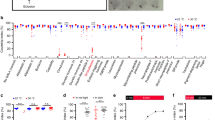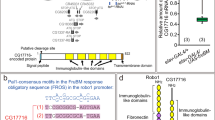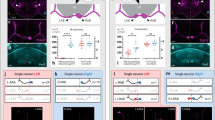Abstract
The Drosophila fruitless (fru) gene product Fru has been postulated to be a neural sex determination factor that directs development of the central nervous system (CNS), thereby producing male-typical courtship behaviour and inducing male-specific muscle1,2,3,4,5,6. Male-specific Fru protein is expressed in small groups of neurons scattered throughout the CNS of male, but not female, Drosophila4,7. Collectively, these observations suggest that Fru ‘masculinizes’ certain neurons, thereby establishing neural substrates for male-typical behaviour. However, specific differences between neurons resulting from the presence or absence of Fru are unknown. Previous studies have suggested that Fru might result in sexual differences in the CNS at the functional level, as no overt sexual dimorphism in CNS structure was discernible8,9,10. Here we identify a subset of fru-expressing interneurons in the brain that show marked sexual dimorphism in their number and projection pattern. We also demonstrate that Fru supports the development of neurons with male-specific dendritic fields, which are programmed to die during female development as a result of the absence of Fru. Thus, Fru expression can produce a male-specific neural circuit, probably used during heterosexual courtship, by preventing cell death in identifiable neurons.
This is a preview of subscription content, access via your institution
Access options
Subscribe to this journal
Receive 51 print issues and online access
$199.00 per year
only $3.90 per issue
Buy this article
- Purchase on Springer Link
- Instant access to full article PDF
Prices may be subject to local taxes which are calculated during checkout



Similar content being viewed by others
References
Ito, H. et al. Sexual orientation in Drosophila is altered by the satori mutation in the sex-determination gene fruitless that encodes a zinc finger protein with a BTB domain. Proc. Natl Acad. Sci. USA 93, 9687–9692 (1996)
Ryner, L. C. et al. Control of male sexual behaviour and sexual orientation in Drosophila by the fruitless gene. Cell 87, 1079–1089 (1996)
Taylor, B. J. & Knittel, L. M. Sex-specific differentiation of a male-specific abdominal muscle, the Muscle of Lawrence, is abnormal in hydroxyurea-treated and in fruitless male flies. Development 121, 3079–3088 (1995)
Usui-Aoki, K. et al. Formation of the male-specific muscle in female Drosophila by ectopic fruitless expression. Nature Cell Biol. 2, 500–506 (2000)
Goodwin, S. F. et al. Aberrant splicing and altered spatial expression patterns in fruitless mutants of Drosophila melanogaster. Genetics 154, 725–745 (2000)
Nilsson, E. et al. fruitless is in the regulatory pathway by which ectopic mini-white and transformer induce bisexual courtship in Drosophila. J. Neurogenet. 13, 213–232 (2000)
Lee, G. et al. Spatial, temporal, and sexually dimorphic expression patterns of the fruitless gene in the Drosophila central nervous system. J. Neurobiol. 43, 404–426 (2000)
Demir, E. & Dickson, B. J. fruitless splicing specifies male courtship behaviour in Drosophila. Cell 121, 785–794 (2005)
Stockinger, P., Kvitsiani, D., Rotkopf, S., Tirian, L. & Dickson, B. J. Neural circuitry that governs Drosophila male courtship behaviour. Cell 121, 795–807 (2005)
Manoli, D. S. et al. Male-specific fruitless specifies the neural substrates of Drosophila courtship behaviour. Nature 436, 395–400 (2005)
Lee, T. & Luo, L. Mosaic analysis with a repressible cell marker for studies of gene function in neuronal morphogenesis. Neuron 22, 451–461 (1999)
White, K. et al. Genetic control of programmed cell death in Drosophila. Science 264, 677–683 (1994)
Peterson, C., Carney, G. E., Taylor, B. J. & White, K. reaper is required for neuroblast apoptosis during Drosophila development. Development 129, 1467–1476 (2002)
Grether, M. E., Abrams, J. M., Agapite, J., White, K. & Steller, H. The head involution defective gene of Drosophila melanogaster functions in programmed cell death. Genes Dev. 9, 1694–1708 (1995)
Lawrence, P. A. & Johnston, P. The muscle pattern of a segment of Drosophila may be determined by neurons and not by contributing myoblasts. Cell 45, 505–513 (1986)
Stocker, R. F. The organization of the chemosensory system in Drosophila melanogaster: a review. Cell Tissue Res. 275, 3–26 (1994)
Thorne, N., Chromey, C., Bray, S. & Amrein, H. Taste perception and coding in Drosophila. Curr. Biol. 14, 1065–1079 (2004)
Wang, Z., Singhvi, A., Kong, P. & Scott, K. Taste representations in the Drosophila brain. Cell 117, 981–991 (2004)
Lienhard, M. C. & Stocker, R. F. Sensory projection patterns of supernumerary legs and aristae in D. melanogaster. J. Exp. Zool. 244, 187–201 (1987)
Murphey, R. K., Possidente, D., Pollack, G. & Merritt, D. J. Modality-specific axonal projections in the CNS of the flies Phormia and Drosophila. J. Comp. Neurol. 290, 185–200 (1989)
Hall, J. C. The mating of a fly. Science 264, 1702–1714 (1994)
Greenspan, R. J. & Ferveur, F. J. Courtship in Drosophila. Annu. Rev. Genet. 34, 205–232 (2000)
Bray, S. & Amrein, H. A putative Drosophila pheromone receptor expressed in male-specific taste neurons is required for efficient courtship. Neuron 39, 1019–1029 (2003)
Awasaki, T. & Kimura, K. pox-neuro is required for development of chemosensory bristles in Drosophila. J. Neurobiol. 32, 707–721 (1997)
Acknowledgements
We thank E. Nilsson for critical reading of the manuscript, J. Maeyama and E. Matsuda for their participation in the early stages of this work, and M. Haga for technical assistance. We also thank K. Ito for the NP21 strain, A. Gould for the Df(3L)H99 FRT A2 strain, K. White for the Df(3L)XR38 strain, H. Steller for the hidA206 strain, A. Hofbauer for the monoclonal nc82 antibody, T. Awasaki, the Bloomington and Kyoto Stock Centers for Drosophila strains, and H. Aonuma for allowing us access to a confocal microscope. This work was supported in part by Special Cooperation Funds for Promoting Science and Technology from MEXT (Ministry of Education, Culture, Sports, Science and Technology in Japan) to K.-I.K. and D.Y.
Author information
Authors and Affiliations
Corresponding author
Ethics declarations
Competing interests
Reprints and permissions information is available at npg.nature.com/reprintsandpermissions. The authors declare no competing financial interests.
Supplementary information
Supplementary Figure S1
This figure shows different patterns of projections observed in the male mAL neurons. Eight types are distinguishable. (DOC 338 kb)
Supplementary Figure S2
This figure shows the involvement of fru in the formation of mAL sexual dimorphism. Phenotipic analysis shows that NP21 is an allele of fruitless. (DOC 415 kb)
Supplementary Figure S3
This figure shows that the mAL neurons which escaped from cell death in females do not express Fru. (DOC 139 kb)
Supplementary Figure S4
This figure shows that male-specific neurons in optic lobe are transmedullary (Tm) neurons connecting the distal medulla with lobula regions. The Tm neurons are present just as in males when cell death was blocked in females and they are not present in the fru mutant male. (DOC 164 kb)
Supplementary Table S1
This table shows courtship behaviour of flies. The NP21 homozygous males displayed dramatically reduced level of courtship behaviour toward males as well as females. The tra1 mutant females vigorously courted partner females, whereas the females in which rpr+ was deleted did not display any male-typical courtship behaviour. (DOC 22 kb)
Rights and permissions
About this article
Cite this article
Kimura, KI., Ote, M., Tazawa, T. et al. Fruitless specifies sexually dimorphic neural circuitry in the Drosophila brain. Nature 438, 229–233 (2005). https://doi.org/10.1038/nature04229
Received:
Accepted:
Issue Date:
DOI: https://doi.org/10.1038/nature04229
This article is cited by
-
Activin is a neural inducer of a male-specific muscle in Drosophila
Scientific Reports (2024)
-
A rapid and bidirectional reporter of neural activity reveals neural correlates of social behaviors in Drosophila
Nature Neuroscience (2023)
-
Serotonin Signaling Modulates Sexual Receptivity of Virgin Female Drosophila
Neuroscience Bulletin (2022)
-
teiresias, a Fruitless target gene encoding an immunoglobulin-superfamily transmembrane protein, is required for neuronal feminization in Drosophila
Communications Biology (2020)
-
Partial proteasomal degradation of Lola triggers the male-to-female switch of a dimorphic courtship circuit
Nature Communications (2019)
Comments
By submitting a comment you agree to abide by our Terms and Community Guidelines. If you find something abusive or that does not comply with our terms or guidelines please flag it as inappropriate.



